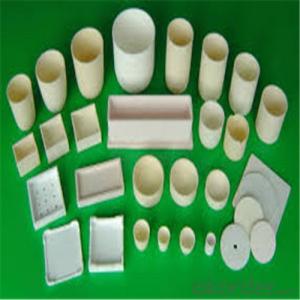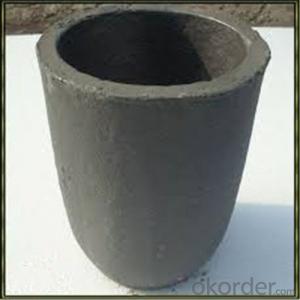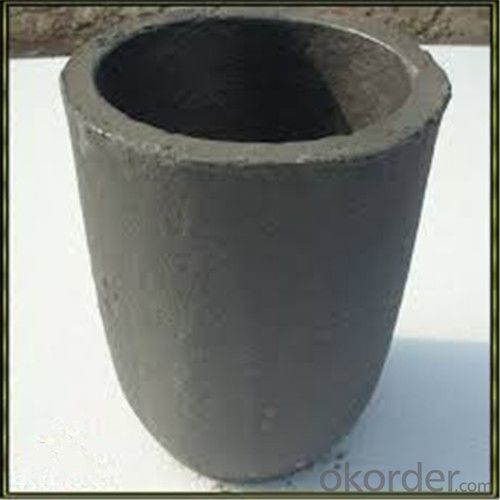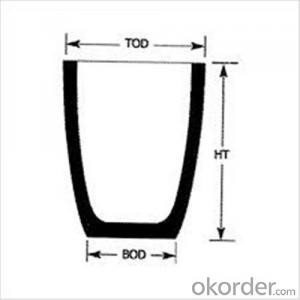Graphite Crucible Near Me for Gold Melting Aluminium and Copper, Brass - SIC Graphite Crucibles
- Loading Port:
- Shanghai
- Payment Terms:
- TT OR LC
- Min Order Qty:
- 1 pc
- Supply Capability:
- 1000 pc/month
OKorder Service Pledge
OKorder Financial Service
You Might Also Like
Quick Details for SiC Graphite Crucibles For Melting Aluminium And Copper, Brass
| Type: | High Strength, graphite crucible crucible | Application: | melting metal | Height: | as your requirements |
| Composition: | High Pure | Top Diameter: | 10-600mm | Bottom Diameter: | 10-1000mm |
| Place of Origin: | China (Mainland) | Brand Name: | Model Number: | ||
| Color: | Black grey | Si3N4%: | 5min | Fe2O3%: | 0.7max |
| C%: | 30-45 | Apparent porosity: | 30max | Refractoriness: | 1680 |
| Bulk Density: | 1.71min | Using life: | >5000 hours | MAX temperature: | 1600c |
Packaging & Delivery
| Packaging Details: | Seaworty packing or as per customer's detail requirement of graphite crucible. |
| Delivery Detail: | within 20-30 days after confirm order of graphite cru |
Super Quality Long Working Life SiC Graphite Crucibles
Product Description
Specifications for Graphite Silicon Carbide Crucible For Aluminum Melting :
1.Long working lifetime: its working lifetime is increased 3-5 times over normal clay-crucible due to the compact body formed under high pressure.
2.High thermal conductivity: high-density body and low apparent porosity greatly improve its heat conductivity.
3.New-style materials: new heat conduction material ensures faster heat conductivity and pollution-free product, reduces adherent slag.
4.Resistance to corrosion:better anti-corrosion than normal clay-crucible.
5.Resistance to oxidation: advanced process dramatically improves its oxidation resistance, which ensures persistent heat conductivity and long working lifetime.
6.High-strength: high-density body and logical structure make the product better compression property.
7.Eco-friendly: energy-efficient and pollution-free, not only ensure metal product purity, but also ensure sustainable development on environment.
8.Multi-function: Can be used in induction graphite crucible furnace
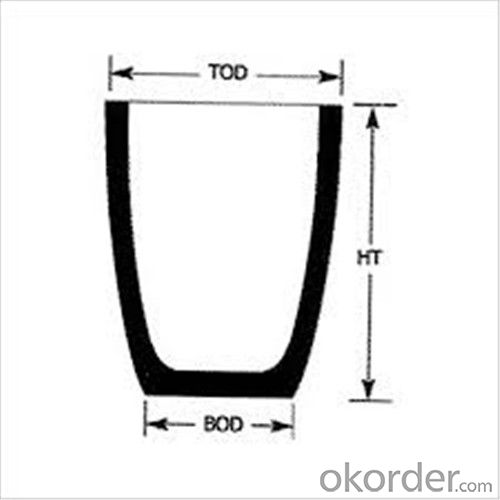

Physicochemical Properties of graphite crucible:
The crucible is an utensil or melting tank vessels that is made of refractory material (such as clay, graphite, quartz or difficult molten metal iron, etc.).
Graphite crucible, with is special advantages and Plasticity, is widely used in the smelting area, e.g. gold smelting, silver smelting, aluminum smelting, cooper smelting, etc.
high pure graphite | ||||
Item | Unit | baked twice | baked three time | baked four times |
impregnated once | impregnated twice | impregnated three times | ||
grain size | mm | ≤325μm | ≤325μm | ≤325μm |
Bulk density | g/cm3 | ≥1.68 | ≥1.78 | ≥1.85 |
Specific resistance | μΩ.m | ≤14 | ≤14 | ≤13 |
Bending strength | MPa | ≥25 | ≥40 | ≥45 |
Compressive strength | MPa | ≥50 | ≥60 | ≥65 |
Ash content | % | ≤0.15 | ≤0.1 | ≤0.05 |
Fine-grain Specialty Graphite FXG-1 | Fine-grain Specialty Graphite FXG-2 | ||||
Item | Unit | Guarantee value | Typical value | Guarantee value | Typical value |
Max grain size | mm | 0.8 | 0.8 | 0.8 | 0.8 |
Bulk density | g/cm3 | ≥1.70 | 1.73 | ≥1.73 | 1.76 |
Specific resistance | μΩ.m | ≤8.5 | 7.5 | ≤8.0 | 7 |
Bending strength | MPa | ≥10.0 | 11 | ≥12.0 | 12.5 |
Compressive strength | MPa | ≥24.0 | 27 | ≥31.0 | 34 |
Thermal Condcutivity | W/(m.k) | ≥120 | 150 | ≥130 | 160 |
C.T.E.(100-600) °C | 10-6/°C | ≤2.5 | 2.2 | ≤2.5 | 2.1 |
Ash content | % | ≤0.3 | 0.09 | ≤0.3 | 0.09 |
NO | Top diameter | Bottom diameter | Height | Tolerance | Capacity(Kg5%) |
2 | 90 | 50 | 55 | 2 | 0.3 |
3 | 105 | 80 | 93 | 2 | 0.5 |
4 | 102 | 80 | 100 | 2 | 0.6 |
5 | 112 | 82 | 130 | 2 | 0.8 |
6 | 120 | 82 | 141 | 2 | 0.9 |
8 | 138 | 90 | 153 | 2 | 1.2 |
12 | 148 | 100 | 181 | 2 | 1.8 |
16 | 156 | 110 | 190 | 2 | 2.3 |
20 | 180 | 120 | 230 | 2 | 3 |
25 | 186 | 128 | 248 | 2 | 3.7 |
Packaging & Shipping
Package: Wooden case and wooden pallet or pack as customer's requirement of graphite crucible.
Delivery time: depend on distance, usually 20 days to 50days after deposit of graphite crucible.
Our Services


Other Products


FAQ
1.What's your MOQ?
We will indicate the MOQ for each item in the quotation list. We accept the sample and trail order.
2.Can I negotiate the Prices?
Sure, we may consider discounts for bulk order of products.
3.How long will it take to complete my order?
For the stock items, we can arrange the shippment within 2~3days after received your payment. For the customized items, we will indicate the delivery time in the quotation list.
4.Can you give warranty of your products?
Yes, we extend a 100% satifisfaction guarantee on all items. Please feel free to provide timely feedback if you're not satisfied with N&D's Quality and Service. For the overseas orders, if there is a quality problem, please kindly to provide the picturers to show the problem by e-mail. We will provide the replacements to you at our cost according to actual conditions.
Welcome to visit our factory.^_^
- Q: Use the tripod why use mud, and mud and three foot tripod supporting in the use of the crucible?
- In addition, the mud triangle is insulated. The crucible is hot, touching the three feet directly, and the three stand will get hot, so you can't move the three leg with your hands
- Q: How should CPP aluminium plating film be produced?. Is the vacuum aluminizing machine necessary? How much is the machine?. What material does CPP aluminum plating film need?.
- CPP film is aluminum barrier films by vacuum aluminum plating process will be a thin layer of aluminum atoms accumulated to CPP film formed on the casting quality, with metal luster bright, excellent gas and light resistance and good moisture, light, can use the advantages of replacing aluminum foil.
- Q: What are the different accessories available for graphite crucibles?
- There are several different accessories available for graphite crucibles that can enhance their performance and make them more suitable for specific applications. Some of the common accessories include: 1. Crucible Tongs: These are long-handled tools specifically designed to safely handle hot crucibles. They allow for easy and secure gripping of the crucible, preventing accidental burns or spills. 2. Crucible Covers: These are lids or covers that can be placed on top of the crucible to protect the contents from contamination or oxidation. They help maintain a controlled environment inside the crucible, ensuring the purity of the materials being melted or heated. 3. Crucible Holders: These are support structures that hold the crucible in place during heating or pouring. They provide stability and prevent the crucible from tipping over or spilling its contents. 4. Crucible Racks: These are storage racks or holders designed to safely store crucibles when they are not in use. They help keep the crucibles organized and prevent any accidental damage or breakage. 5. Crucible Stirrers: These are specialized tools used to stir the contents inside the crucible during melting or mixing processes. They assist in achieving uniform temperature distribution and homogeneity of the molten material. 6. Crucible Cleaning Tools: These tools are used to clean the graphite crucible after use, removing any residue or impurities. They may include brushes, scrapers, or solvents specifically designed for graphite crucibles. 7. Crucible Lids: In addition to covers, there are also specialized lids that can be used to seal the crucible tightly during certain applications. These lids help create a controlled atmosphere or prevent the escape of volatile substances. 8. Crucible Lifters: These tools are used to safely lift and transport hot crucibles from one location to another. They are designed to withstand high temperatures and provide a secure grip on the crucible. 9. Crucible Insulation: Insulating materials such as ceramic fiber blankets or jackets can be used to surround the graphite crucible, providing additional thermal insulation. This helps to maintain a consistent temperature and prevent heat loss. 10. Crucible Liners: Liners made of ceramic or other refractory materials can be used to protect the graphite crucible from chemical reactions or erosion caused by aggressive materials or corrosive environments. These accessories offer various advantages and options to optimize the performance and utilization of graphite crucibles based on specific requirements and applications.
- Q: Can graphite crucibles be used for powder compaction?
- Yes, graphite crucibles can be used for powder compaction. Graphite crucibles are typically made of high-quality graphite material, which has excellent thermal conductivity and high temperature resistance. These properties make graphite crucibles suitable for various high-temperature applications, including powder compaction. During the powder compaction process, the graphite crucible can withstand high pressures and temperatures, ensuring that the powder is compacted effectively. The crucible's high thermal conductivity helps in distributing heat evenly, allowing for uniform compaction of the powder. Additionally, graphite crucibles can be easily machined into different shapes and sizes, making them versatile and adaptable for different powder compaction requirements. Their non-reactive nature with most substances also makes them suitable for handling a wide range of powders without the risk of contamination. However, it is important to consider the specific requirements of the powder being compacted and the compaction process itself. Certain powders may require specialized crucibles made of alternative materials to ensure optimal results. Therefore, it is recommended to consult with experts or conduct thorough research to determine the suitability of graphite crucibles for a particular powder compaction application.
- Q: What are the advantages of a smelting furnace using induction heating, and will it reduce costs?
- The A option shows that the B error; C, the eddy current in the pan is related to the frequency of the magnetic field changes, so C is correct;
- Q: How does the gas permeability of graphite affect crucible performance?
- The gas permeability of graphite plays a crucial role in crucible performance. Graphite's high gas permeability allows for the escape of gases and volatile compounds during high-temperature processes. This helps prevent pressure build-up, potential explosions, and contamination of the material being processed. Additionally, the permeability of graphite assists in maintaining a stable temperature within the crucible, enhancing the efficiency and effectiveness of the overall process.
- Q: Can a graphite crucible be used for gold or silver melting?
- Yes, a graphite crucible can be used for gold or silver melting. Graphite crucibles have high thermal conductivity, which allows for efficient heat transfer during melting. Additionally, graphite has a high melting point and is chemically resistant, making it suitable for withstanding the high temperatures and corrosive environments associated with gold and silver melting. Graphite crucibles are commonly used in various industrial applications, including metallurgy, jewelry making, and dental laboratories, for melting and casting precious metals like gold and silver.
- Q: What are the differences in production techniques for different graphite crucible models?
- Graphite crucible is one of the indispensable tools in modern metallurgical industry. Especially when smelting special and non-ferrous metals and their alloys, graphite crucibles still need to be used.
- Q: Why is graphite crucible smelting reducing properties of the burden is particularly vulnerable to corrosion?
- Corrosion, the nature of the general graphite is extremely stable, it is difficult to corrosion, but some special organic substances, such as resin at low temperatures, will be able to graphite erosion, making the graphite due to mechanical strength and damage. And some oxygenated compounds, too.
- Q: What is the importance of carbon graphite as biological material?
- As a wear-resistant and lubricating material, graphite is often used as a lubricant in the mechanical industry. Lubricants can not be used in high speed, high temperature, high pressure conditions, and graphite wear-resistant materials can be at -200 - 2000 temperature, and at a high sliding speed, without lubricating oil work. Many transporting corrosive media devices are widely used, which is made of graphite material piston ring, the sealing ring and the bearing, they are running, without adding lubricating oil, graphite and many metal processing (drawing, drawing) the good lubricant.
Send your message to us
Graphite Crucible Near Me for Gold Melting Aluminium and Copper, Brass - SIC Graphite Crucibles
- Loading Port:
- Shanghai
- Payment Terms:
- TT OR LC
- Min Order Qty:
- 1 pc
- Supply Capability:
- 1000 pc/month
OKorder Service Pledge
OKorder Financial Service
Similar products
Hot products
Hot Searches
Related keywords



